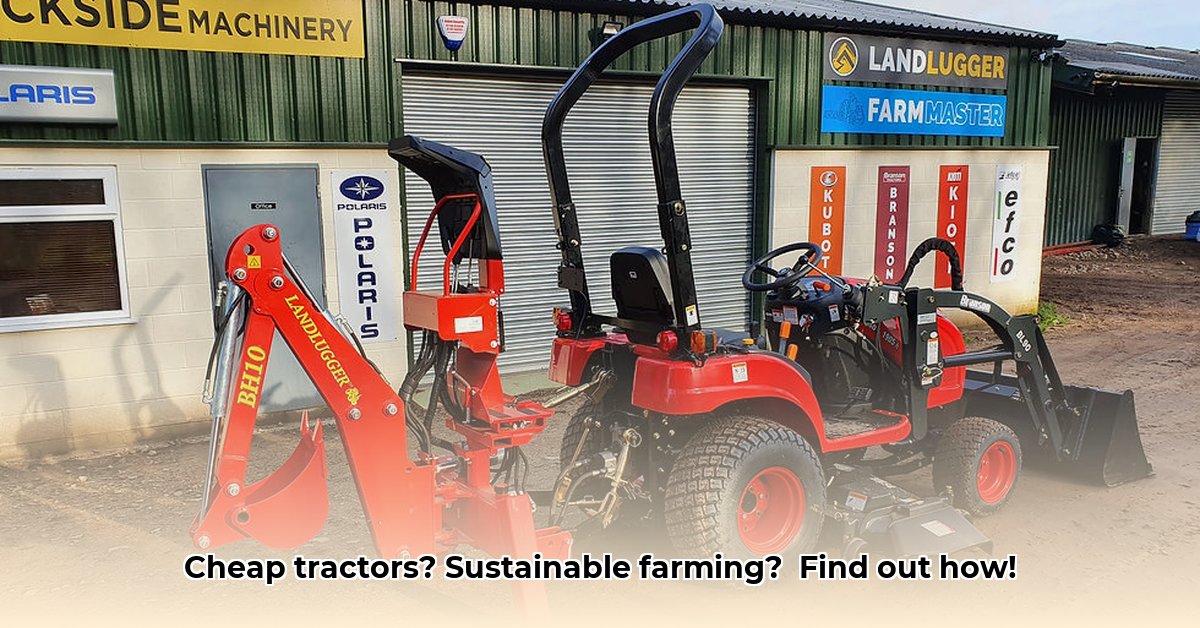
Finding the right tractor for your farm shouldn't break the bank. This guide helps small-scale farmers navigate the world of affordable tractors, emphasizing practical advice for sustainable farming operations. Let's get started! If buying isn't an option, consider the tractor rental costs.
Understanding Your Farming Needs: The Foundation of Smart Tractor Shopping
Before researching horsepower or PTO (Power Take-Off – the power used to operate implements), honestly assess your farm's needs. What tasks will your tractor perform? Are you plowing large fields, tilling smaller plots, or handling various tasks? Consider acreage and the types of implements you'll need. A small family farm might need a compact tractor, while a larger operation requires more power. Proper sizing maximizes your investment and minimizes long-term costs. Don't overbuy; buy smart! This is the cornerstone of securing a fuel-efficient tractor suitable for your operations.
Exploring Your Options: Different Types of Affordable Tractors
The market offers various options, each with advantages and disadvantages. Let's examine some common types:
Used Tractors: Buying pre-owned significantly reduces upfront costs. However, a meticulous inspection is crucial. Look for wear and tear, especially on the engine and transmission. Consider engaging a qualified mechanic for a pre-purchase inspection; this upfront expense can prevent costly repairs later. While used equipment costs less initially, it can incur more expenses through repairs.
New Budget-Friendly Models: These offer warranty protection and access to newer, potentially more fuel-efficient technology. However, they might lack advanced features. Carefully weigh features against your actual farming needs to avoid unnecessary expenses. Budget-friendly models are a good compromise between cost and reliability.
| Tractor Type | Advantages | Disadvantages | Key Considerations |
|---|---|---|---|
| Used Compact Tractors | Significantly lower initial cost; often simpler to maintain | Higher potential for repairs; may have older technology | Pre-purchase inspection by a qualified mechanic is essential. |
| New Budget-Friendly Models | Warranty; access to newer technologies; potentially better fuel efficiency | May lack advanced features; potentially higher upfront cost. | Balance features with your specific farm tasks and your budget. |
Finding Your Perfect Tractor: A Step-by-Step Guide
Thorough Research: Explore online marketplaces (like TractorHouse.com) and local dealerships. Compare models and specifications. Pay close attention to user reviews, focusing on reliability and maintenance needs.
Smart Comparisons: Focus on PTO horsepower. This reflects the tractor's ability to power implements. It's a more reliable indicator of working capacity than engine horsepower alone.
Meticulous Inspection (for Used Tractors): If buying used, a thorough pre-purchase inspection is essential. Examine the engine, transmission, hydraulics, and attachments. A professional mechanic can identify potential issues.
Negotiate Wisely: Negotiate the price, especially for used tractors. Dealerships often have flexibility. Be prepared to discuss your budget openly and strategically.
Explore Financing: Consider financing options such as agricultural equipment loans. Research government subsidies or programs supporting small-scale farmers. Choosing the right financing can significantly impact affordability.
Essential Features: Balancing Affordability and Functionality
Prioritize fuel efficiency for long-term cost savings. Ease of maintenance minimizes repair costs. Reliability of key components, like the engine and transmission, is crucial. Look for durable models even if they cost slightly more upfront; the investment pays off over time.
Technology in Affordable Tractors: Smart Choices
GPS guidance and auto-steer can increase efficiency but often cost more. Consider whether these features justify the added expense. A well-maintained used tractor with upgrade potential can be a better investment than a new basic model lacking crucial features. Prioritize features vital to your farm operation. Sometimes, less is more. What are the absolute must-have features for your farm's operations?
Keeping Your Tractor Running Smoothly: The Importance of Maintenance
Regular maintenance extends the life of any tractor. A well-maintained machine, even an inexpensive one, delivers reliable service, minimizing repairs and extending lifespan. Develop a regular maintenance schedule. This is vital for both cost savings and safety. What is your farm's regular maintenance schedule for tractors?
Sustainable Farming and Affordable Tractors: Working Together
Sustainable farming demands efficient resource management. Choosing an appropriate, affordable tractor contributes to both environmental stewardship and economic sustainability. A well-maintained, appropriately sized tractor is an investment that helps your farm thrive for years to come. How does the choice of a fuel-efficient tractor support your long-term sustainable farming goals?
How to Choose a Fuel-Efficient Tractor for Small Sustainable Farms
Key Takeaways:
- Prioritize fuel efficiency and versatility.
- Consider long-term costs (fuel, maintenance, repairs).
- Explore compact tractors (40-70 HP) for smaller farms; larger operations might need more powerful models.
- Investigate financing options and government subsidies.
- Used tractors offer cost savings but require thorough inspection.
- Implement precision farming technologies to increase efficiency and minimize waste.
- The transition to electric or alternative fuel tractors is a long-term goal.
Pros and Cons of Different Fuel Types
| Fuel Type | Pros | Cons |
|---|---|---|
| Diesel | Powerful, widely available, robust engines | Higher emissions, relatively high fuel cost |
| Electric | Zero emissions, quiet operation | High initial cost, limited range, charging needs |
| Biofuel | Renewable, reduced emissions | Availability may be limited, potential for higher maintenance |
Remember, the best tractor is the one that best fits your farm's needs and budget while supporting your long-term sustainability goals. Careful planning and thorough comparison will lead you to the right choice.